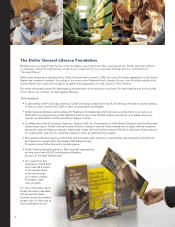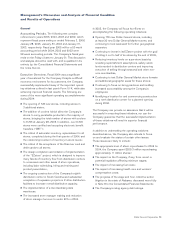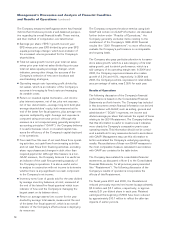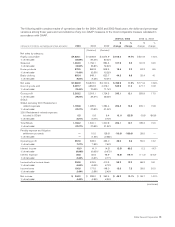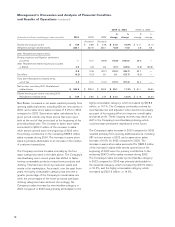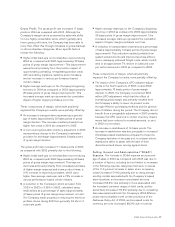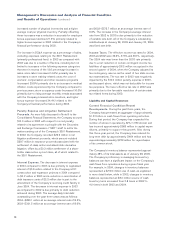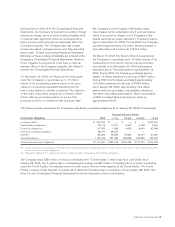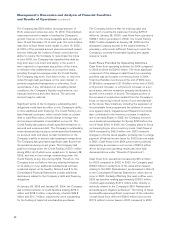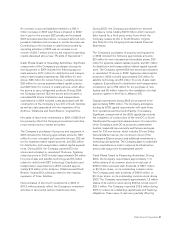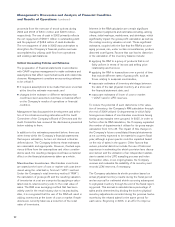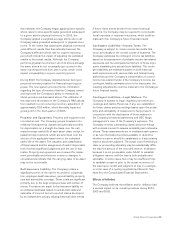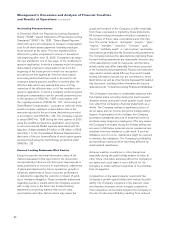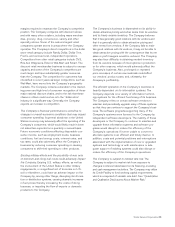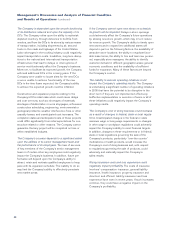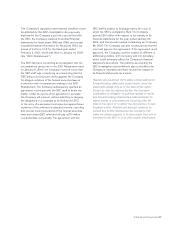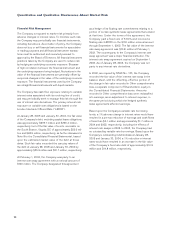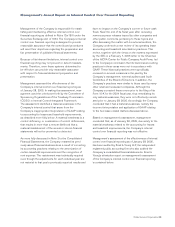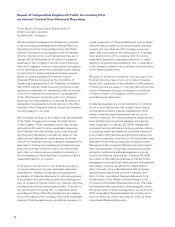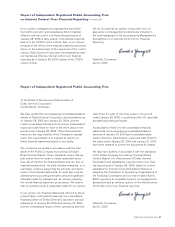Dollar General 2004 Annual Report Download - page 24
Download and view the complete annual report
Please find page 24 of the 2004 Dollar General annual report below. You can navigate through the pages in the report by either clicking on the pages listed below, or by using the keyword search tool below to find specific information within the annual report.22
Management’s Discussion and Analysis of Financial Condition
and Results of Operations (continued)
proceeds from the exercise of stock options during
2004 and 2003 of $34.1 million and $49.5 million,
respectively. The use of cash in 2002 primarily reflects
the net repayment of $397.1 million in outstanding debt
and the payment of $42.6 million of cash dividends.
The net repayment of debt in 2002 was undertaken to
strengthen the Company’s financial position and was
accomplished by utilizing cash flow from operations
and existing cash balances.
Critical Accounting Policies and Estimates
The preparation of financial statements in accordance
with GAAP requires management to make estimates and
assumptions that affect reported amounts and related dis-
closures. Management considers an accounting estimate
to be critical if:
■ it requires assumptions to be made that were uncertain
at the time the estimate was made; and
■ changes in the estimate or different estimates that
could have been selected could have a material effect
on the Company’s results of operations or financial
condition.
Management has discussed the development and selec-
tion of its critical accounting estimates with the Audit
Committee of the Company’s Board of Directors and the
Audit Committee has reviewed the disclosures presented
below relating to them.
In addition to the estimates presented below, there are
other items within the Company’s financial statements
that require estimation, but are not deemed critical as
defined above. The Company believes these estimates
are reasonable and appropriate. However, if actual expe-
rience differs from the assumptions and other consider-
ations used, the resulting changes could have a material
effect on the financial statements taken as a whole.
Merchandise Inventories. Merchandise inventories
are stated at the lower of cost or market with cost deter-
mined using the retail last-in, first-out (“LIFO”) method.
Under the Company’s retail inventory method (“RIM”),
the calculation of gross profit and the resulting valuation
of inventories at cost are computed by applying a calcu-
lated cost-to-retail inventory ratio to the retail value of
sales. The RIM is an averaging method that has been
widely used in the retail industry due to its practicality.
Also, it is recognized that the use of the RIM will result in
valuing inventories at the lower of cost or market if mark-
downs are currently taken as a reduction of the retail
value of inventories.
Inherent in the RIM calculation are certain significant
management judgments and estimates including, among
others, initial markups, markdowns, and shrinkage, which
significantly impact the gross profit calculation as well as
the ending inventory valuation at cost. These significant
estimates, coupled with the fact that the RIM is an aver-
aging process, can, under certain circumstances, produce
distorted cost figures. Factors that can lead to distortion
in the calculation of the inventory balance include:
■ applying the RIM to a group of products that is not
fairly uniform in terms of its cost and selling price
relationship and turnover;
■ applying the RIM to transactions over a period of time
that include different rates of gross profit, such as
those relating to seasonal merchandise;
■ inaccurate estimates of inventory shrinkage between
the date of the last physical inventory at a store and
the financial statement date; and
■ inaccurate estimates of lower of cost or market
(“LCM”) and/or LIFO reserves.
To reduce the potential of such distortions in the valua-
tion of inventory, the Company’s RIM calculation through
the end of 2004 utilized 10 departments in which fairly
homogenous classes of merchandise inventories having
similar gross margins were grouped. In 2005, in order to
further refine its RIM calculation, the Company expanded
the number of departments it utilizes for its gross margin
calculation from 10 to 23. The impact of this change on
the Company’s future consolidated financial statements
is not currently expected to be material to a given fiscal
year, although a given quarter could be impacted based
on the mix of sales in the quarter. Other factors that
reduce potential distortion include the use of historical
experience in estimating the shrink provision (see discus-
sion below) and the utilization of an independent statisti-
cian to assist in the LIFO sampling process and index
formulation. Also, on an ongoing basis, the Company
reviews and evaluates the salability of its inventory and
records LCM reserves, if necessary.
The Company calculates its shrink provision based on
actual physical inventory results during the fiscal period
and an accrual for estimated shrink occurring subsequent
to a physical inventory through the end of the fiscal report-
ing period. This accrual is calculated as a percentage of
sales and is determined by dividing the book-to-physical
inventory adjustments recorded during the previous twelve
months by the related sales for the same period for
each store. Beginning in 2003, in an effort to improve


